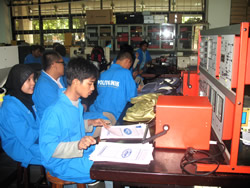Workforce Development
 |
| Students receive short-term vocational training at Politeknik Caltex Riau, an Indonesian polytechnic university, under a USAID/Chevron partnership for tsunami recovery |
USAID works with developing countries to build the skills and capacity of their workforces to support economic growth and competitiveness, as well as to stabilize societies after conflict or natural disaster. Workforce development programs assist youth and adults in acquiring knowledge and developing skills, attitudes, and behaviors to find legitimate jobs, establish viable self-employment ventures, and stay employed and productive in a changing economy. USAID programs create policies, programs, and systems that respond to labor market demands in both the formal and informal sectors. Linking the public and private sectors through partnerships is a hallmark of USAID’s approach to building sustainable, demand-driven workforce programs.
Workforce development program areas include systemic reform, partnership development, workforce readiness, and technical/vocational education and training. Activities include:
- Delivering holistic programming to at-risk, out-of-school youth in post-conflict environments to help them develop livelihood skills, find or create employment, and continue with their education.
- Connecting secondary school and university students to employers through career development programs, mentoring, internships, and job placement services.
- Developing youth employability skills, such as critical thinking and facility with computer technology, as well as specific technical/vocational skills, in response to industry workforce demands.
- Building linkages between education and training institutions, private sector companies, and community groups to build local and regional competitiveness and satisfy needs for qualified workers.
- Assisting developing country governments to develop and implement sound policies and build capacity to manage workforce development systems.
To learn more about current youth workforce development programs see:
To learn about recently completed workforce development projects see:
Back to Top ^ |


